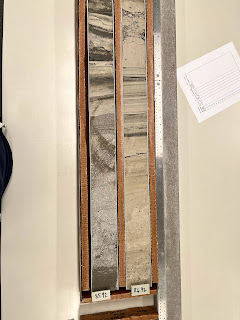At the end of May, 2022, I was afforded the opportunity to attend Glacial Sedimentation School (GLASS) hosted at the marine core repository at Oregon State University. The core repository was finished in 2020, and this workshop was the first event to be hosted at the new facility. There are over 35 km of marine sediment core from thousands of sites in the world’s oceans stored here, all available upon request.
There were 26 students from multiple countries in attendance, and we were split into four groups, each group in charge of analyzing a set of cores. My group had the privilege of analyzing four sections of the ANDRILL 1B site extracted from the Ross Sea, Antarctica. The ANDRILL 1B core, drilled in 2006, broke a record at 1284.87 m long, the longest drilled core at that time. It was first necessary to drill through ~85 m of ice and 900 m of water before reaching the seafloor sediment.
We started with core descriptions, detailing the visual aspects of each section: laminations, bioturbation, whether or not there were clasts, etc. The next day we made smear slides, focusing on areas of the cores we found to be particularly interesting. Looking at the smear slides through microscopes, it was possible to assess the abundance of silt, clay, and biogenic sedimentation in different deposits in the core. On day three we took our cores to the physical properties lab and analyzed density and magnetic susceptibility. The final lab day we determined the chronology of our cores using magnetostratigraphic and biostratigraphic data. We presented our results on the fifth and final day of the workshop.
In addition to the above lab work, each day, our instructors and mentors would give lectures pertinent to our analyses. Some lectures were on different types of corers, using seismic data to select drilling sites, and how to construct an age model, among many other topics. This workshop was an excellent introduction to practical skills needed for physical core analysis. It was also a wonderful opportunity to meet peers from around the world working on projects similar to mine; one of my team members and I had actually worked on samples from the same core. I also met in-person someone I had previously only known through online meetings. It was so interesting to hear about the various research everyone was doing, and I look forward to meeting again, and perhaps collaborating with, those I met at this workshop in the future.





